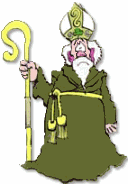Discovery Assignment - Final Project
Irish Immigration of the 1700’s and America’s Nativist Response

Sad Irish Catholic. Clipart. Paddy's Day Image Collection. <http://paddysday.us/webset/StPaddytoon.gif>.
During the Irish immigration wave beginning from the
early 1700’s and lasting until the Revolutionary War of 1776,
many had traveled from Ireland to New England, which had later become
the United States of America. Throughout this wave around a quarter
million of Irish had come to America in search of a better life either
in search of job opportunity or to flee the increasing English rule in
Ireland (Yale). With such a large population coming in to inhabit a
newer colony like New England, encouraging change and consequentially a
nativist reaction amongst the colonists who were already present in the
New England area, seemed inevitable. However in most cases, the
anti-foreign sentiments that arise from increased immigration generally
tend to be based on race, but for this wave and time period, the ill
sentiments arose from religious splits among Irish Protestants and
Irish Catholics.
The wave of Irish immigration prior to that of this
colonial period involved many Protestants (primarily English and some
Irish) groups coming to settle New England. Some of these protestants
were still immigrating to America by the early 1700’s (McCormack). So
for the first section of this wave, about 1700 to the 1730’s, the
colonists had little problems with the newcomers. “Some ships
were able to land at American ports in that year [1714] and after that
a few more ships were admitted each year, until 1718, when as many as
15 ships may have off-loaded Settlers at northern American ports. The
American Colonies had…opened up their ports to Irish
Immigrants” (Migrations). The only concern that had arisen by the
1730’s was the number of the Irish coming through. Areas such as
Pennsylvania imposed head taxes to try to discourage more foreigners
from coming in to the colonies (Immigration). Aside from the population
concern, the main issue was the religious identity of the newcomers.
However, it wasn’t until the later part of the
colonial wave that Irish Catholics started coming to New England; and
that is primarily where the anti-immigration sentiments had begun
(McCormack). Previously in Ireland, the original Protestants came here
because of prior religious persecution from Catholic English rulers,
but due to political events and new leaders, as well as the switching
of the English religion from Catholicism to Anglican, the Catholics
were now the new target of persecution (McCormack). Because of the Anglican
church and British influence in New England, religious tolerance really
only applied to the Protestants and the Catholics were stripped of many
of their worshipping rights (McCormack). Also penal laws had been enacted in
New York to discourage Catholic settlement and worship, too (McCormack). With
an original population consisting of Protestant Irish people in the
colonies and the gradual income of Irish Catholics, it is obvious as to
how and why the negative sentiments arose between the two religious
factions.
The main social and political events occurring in
the colonies during this time was the Revolutionary War and the
eventual signing of the Declaration of Independence to create the
United States of America. Because the war was being fought between the
Americans and the English (who had control over Ireland), Irish
immigration had slowed down significantly (Bryant). The few immigrants
who did come over here were questioned of their loyalty, especially
those of Catholic religious identity because of the Catholic allegiance
to the pope (McCormack). The war was lead by many Protestant leaders such as
George Washington himself, who supported an anti-Catholic campaign.
“The first flag raised by the Sons of Liberty in New York was
inscribed ‘No Popery’” (McCormack). This anti-Catholic
sentiment continued after independence had been declared also.
“At the Constitutional Convention in 1777, a strong anti-Catholic
faction was led by John Jay, first Chief Justice of the United States,
who denied civil rights to Catholics until they swore an oath
renouncing the authority of the Pope” (McCormack). Essentially,
Catholics had to give up their religious authority in order to hold
offices or even be equal citizens in the U.S. and the sentiment
continued into the nineteenth century.
Irish immigration and the nativist response in the
late colonial period in New England is mainly a result from the
Catholic and Protestant split, the political-religious events in
England, and the colonial war of independence. The initial part of the
1700 wave only brought about concerns of population and the usual
competition for work, land, etc. between the old colonists and the
newcomers (Bryant). However as discontent with British rule and Catholic
presence increased in the colonies of New England, anti-foreign
sentiment grew, slowing down the rate of immigration by the time of the
Revolutionary War; and this sentiment carried on in U.S. history for
many years and with future immigrant waves.

